Using an Artificial-Intelligence-Generated Program for Positive Efficiency in Filmmaking Education: Insights from Experts and Students
Abstract
:1. Introduction
2. Literature Review
2.1. The Integration of AI into Education
2.2. Filmmaking Education and the Integration of AI into Education
2.3. The Role of AI in Enhancing Filmmaking Education
3. Method
3.1. Filmmaking Education in Prominent Universities
3.1.1. Basic Stage Courses
- Directing language and technique;
- Editing and post-production;
- Screen performance;
- Digital creativity and content creativity.
3.1.2. Practice Stage Courses
- Script writing;
- The production of short films;
- Practicum in cinematography;
- The production of short films.
3.1.3. Studio Stage Courses
- Directing and film creation;
- Documentary creation;
- Cinematic arts laboratory;
- Collaborative group projects;
- Industrial research projects.
3.2. AI Recommendations for Course Enhancement
3.3. Research Design
3.4. First-Round Interviews: Industry Experts
3.5. Second-Round Interviews: Filmmaking Students
3.6. Data Analysis
- Data familiarization: transcriptions of the interviews were reviewed multiple times for the researchers to become immersed in the data;
- Initial coding: meaningful segments of data were assigned initial codes, capturing key ideas and concepts;
- Theme generation: the codes were grouped into potential themes based on shared concepts or sentiments;
- Theme refinement: the themes were refined through continuous review, ensuring that they accurately represented the data;
- Theme clustering: the themes were clustered to generate comprehensive insights and meaningful patterns.
3.7. Ethical Considerations
4. Results
4.1. User Journey Maps: Experts
4.2. The User Journey Maps: Filmmaking Students
4.3. Comparative Analysis
- Common Perspectives:
- Divergent Perspectives and Their Reasons:
- 1.
- The Integration of Culture and Humanity
- 2.
- Technical Course Insufficiency
- 3.
- Timeliness and Real-World Relevance
5. Discussion
5.1. Findings
5.2. Theoretical and Practical Implications
5.3. Limitation
6. Conclusions
Author Contributions
Funding
Institutional Review Board Statement
Data Availability Statement
Conflicts of Interest
Appendix A. Interview Guide (Experts)
- Can you briefly describe your background and your experience in filmmaking education?
- 2.
- In your experience, what are the characteristics of the curriculum in the three phases of filmmaking education: basic, practice and studio?
- 3.
- This is the information on the curriculum of filmmaking majors in comprehensive universities in China, the United States, and Europe collected in our desk research for this study, what do you think about these curriculums?
- 4.
- This is information about AI’s recommended curriculum for filmmaking education, how do you think AI’s recommendations compare to the real curriculum?
- 5.
- What aspects of a filmmaking curriculum are most important to develop in students? (e.g., creativity, technique, practical experience, etc.)
- 6.
- What is the importance of the balance between creativity and technology for student development in filmmaking education?
- 7.
- What are some of the issues students may have with the actual film production project management course?
- 8.
- What are your thoughts on the use of AI in filmmaking education?
- 9.
- What value do you think AI can provide to filmmaking education?
- 10.
- What kind of challenges may filmmaking education face when integrating AI in the future?
- Briefly describe your background and your learning experience in filmmaking?
- 2.
- This is the curriculum information of filmmaking education in comprehensive universities in China, the United States, and Europe collected in our desk research for this study. How are these curriculums in your study experience?
- 3.
- This is information about AI’s recommended course curriculum for filmmaking, how do you feel about AI’s recommendations compared to the real curriculum?
- 4.
- What aspects of the filmmaking curriculum do you think are most important to your development? (e.g., creativity, technology, hands-on experience, etc.)
- 5.
- In the study of filmmaking, which do you think you prefer between creativity and technology?
- 6.
- Do you have a course like Project Management for Filmmaking in your program? If so, what problems did you encounter while taking it?
- 7.
- What are your thoughts on the use of AI in filmmaking education?
- 8.
- Does AI’s recommendation match your learning interests and direction?
- 9.
- You’ve heard in previous interviews what experts think about AI in filmmaking education. Do you share any of these views? Are there some aspects that you have a different view on?
Appendix B. Some of the textual content of the interaction with ChatGPT (Figure 4)
- ME:
- CHATGPT:
- Basic Stage:
- Practice Stage:
- Studio Stage:
References
- Horáková, T.; Houška, M.; Dömeová, L. Classification of the Educational Texts Styles with the Methods of Artificial Intelligence. J. Balt. Sci. Educ. 2017, 16, 324–336. [Google Scholar] [CrossRef]
- Baker, R.S.; Martin, T.; Rossi, L.M. Educational Data Mining and Learning Analytics. In The Wiley Handbook of Cognition and Assessment; John Wiley & Sons, Ltd.: Hoboken, NJ, USA, 2016; pp. 379–396. ISBN 978-1-118-95658-8. [Google Scholar]
- Kasneci, E.; Sessler, K.; Küchemann, S.; Bannert, M.; Dementieva, D.; Fischer, F.; Gasser, U.; Groh, G.; Günnemann, S.; Hüllermeier, E.; et al. ChatGPT for Good? On Opportunities and Challenges of Large Language Models for Education. Learn. Individ. Differ. 2023, 103, 102274. [Google Scholar] [CrossRef]
- Dai, Y.; Chai, C.-S.; Lin, P.-Y.; Jong, M.S.-Y.; Guo, Y.; Qin, J. Promoting Students’ Well-Being by Developing Their Readiness for the Artificial Intelligence Age. Sustainability 2020, 12, 6597. [Google Scholar] [CrossRef]
- Am, J.B.; Furstenthal, L.; Jorge, F.; Roth, E. Innovation in a Crisis: Why It Is More Critical than Ever; McKinsey & Company: New York, NY, USA, 2020. [Google Scholar]
- Momot, I. Artificial Intelligence in Filmmaking Process: Future Scenarios. Bachelor’s Thesis, Jamk University of Applied Sciences, Jyväskylä, Finland, 2022. [Google Scholar]
- Zhai, X.; Chu, X.; Chai, C.S.; Jong, M.S.Y.; Istenic, A.; Spector, M.; Liu, J.-B.; Yuan, J.; Li, Y. A Review of Artificial Intelligence (AI) in Education from 2010 to 2020. Complexity 2021, 2021, 8812542. [Google Scholar] [CrossRef]
- White, J.; Hays, S.; Fu, Q.; Spencer-Smith, J.; Schmidt, D.C. ChatGPT Prompt Patterns for Improving Code Quality, Refactoring, Requirements Elicitation, and Software Design. arXiv 2023, arXiv:2303.07839. [Google Scholar]
- Dai, H.; Liu, Z.; Liao, W.; Huang, X.; Cao, Y.; Wu, Z.; Zhao, L.; Xu, S.; Liu, W.; Liu, N.; et al. AugGPT: Leveraging ChatGPT for Text Data Augmentation. arXiv 2023, arXiv:2302.13007. [Google Scholar]
- Khan, R.A.; Jawaid, M.; Khan, A.R.; Sajjad, M. ChatGPT—Reshaping Medical Education and Clinical Management. Pak. J. Med. Sci. 2023, 39, 605–607. [Google Scholar] [CrossRef] [PubMed]
- Wollowski, M. Using ChatGPT to Produce Code for a Typical College-level Assignment. AI Mag. 2023, 44, 129–130. [Google Scholar] [CrossRef]
- Du, H.; Teng, S.; Chen, H.; Ma, J.; Wang, X.; Gou, C.; Li, B.; Ma, S.; Miao, Q.; Na, X.; et al. Chat with ChatGPT on Intelligent Vehicles: An IEEE TIV Perspective. IEEE Trans. Intell. Veh. 2023, 8, 2020–2026. [Google Scholar] [CrossRef]
- Shen, Y.; Song, K.; Tan, X.; Li, D.; Lu, W.; Zhuang, Y. HuggingGPT: Solving AI Tasks with ChatGPT and Its Friends in Hugging Face. arXiv 2023, arXiv:2303.17580. [Google Scholar]
- Moreno-Guerrero, A.-J.; López-Belmonte, J.; Marín-Marín, J.-A.; Soler-Costa, R. Scientific Development of Educational Artificial Intelligence in Web of Science. Future Internet 2020, 12, 124. [Google Scholar] [CrossRef]
- Montebello, M. AI Injected E-Learning; Studies in Computational Intelligence; Springer International Publishing: Cham, Switzerland, 2018; Volume 745, ISBN 978-3-319-67927-3. [Google Scholar]
- Salvagno, M.; Taccone, F.S.; Gerli, A.G. Can Artificial Intelligence Help for Scientific Writing? Crit. Care 2023, 27, 75. [Google Scholar] [CrossRef]
- Williamson, B. Big Data in Education: The Digital Future of Learning, Policy and Practice; SAGE Publications Ltd.: Thousand Oaks, CA, USA, 2017; 256p. [Google Scholar]
- Zhou, J. Virtual Reality Sports Auxiliary Training System Based on Embedded System and Computer Technology. Microprocess. Microsyst. 2021, 82, 103944. [Google Scholar] [CrossRef]
- Castro Pena, M.L.; Carballal, A.; Rodríguez-Fernández, N.; Santos, I.; Romero, J. Artificial Intelligence Applied to Conceptual Design. A Review of Its Use in Architecture. Autom. Constr. 2021, 124, 103550. [Google Scholar] [CrossRef]
- Dergaa, I.; Chamari, K.; Zmijewski, P.; Ben Saad, H. From Human Writing to Artificial Intelligence Generated Text: Examining the Prospects and Potential Threats of ChatGPT in Academic Writing. Biol. Sport 2023, 40, 615–622. [Google Scholar] [CrossRef] [PubMed]
- Gao, C.A.; Howard, F.M.; Markov, N.S.; Dyer, E.C.; Ramesh, S.; Luo, Y.; Pearson, A.T. Comparing Scientific Abstracts Generated by ChatGPT to Original Abstracts Using an Artificial Intelligence Output Detector, Plagiarism Detector, and Blinded Human Reviewers. NPJ Digit. Med. 2023, 6, 75. [Google Scholar] [CrossRef] [PubMed]
- Khalil, M.; Er, E. Will ChatGPT Get You Caught? Rethinking of Plagiarism Detection. arXiv 2023, arXiv:2302.04335. [Google Scholar]
- Saeidnia, H.R.; Lund, B.D. Non-Fungible Tokens (NFT): A Safe and Effective Way to Prevent Plagiarism in Scientific Publishing. Libr. Hi Tech News 2023, 40, 18–19. [Google Scholar] [CrossRef]
- King, M.R.; ChatGPT. A Conversation on Artificial Intelligence, Chatbots, and Plagiarism in Higher Education. Cell. Mol. Bioeng. 2023, 16, 1–2. [Google Scholar] [CrossRef] [PubMed]
- Popenici, S.A.D.; Kerr, S. Exploring the Impact of Artificial Intelligence on Teaching and Learning in Higher Education. Res. Pract. Technol. Enhanc. Learn. 2017, 12, 22. [Google Scholar] [CrossRef] [PubMed]
- Ge, Z.; Hu, Y. Innovative Application of Artificial Intelligence (AI) in the Management of Higher Education and Teaching. J. Phys. Conf. Ser. 2020, 1533, 032089. [Google Scholar] [CrossRef]
- Samarakou, M.; Fylladitakis, E.; Fruh, W.G.; Karolidis, D.; Hatziapostolou, A.; Athinaios, S.; Grigoriadou, M. Evaluation of an Intelligent Open Learning System for Engineering Education. Knowl. Manag. E-Learn. Int. J. 2016, 8, 496–513. [Google Scholar] [CrossRef]
- Liu, M.; Wang, Y.; Xu, W.; Liu, L. Automated Scoring of Chinese Engineering Students’ English Essays. Int. J. Distance Educ. Technol. 2017, 15, 52–68. [Google Scholar] [CrossRef]
- Jain, G.P.; Gurupur, V.P.; Schroeder, J.L.; Faulkenberry, E.D. Artificial Intelligence-Based Student Learning Evaluation: A Concept Map-Based Approach for Analyzing a Student’s Understanding of a Topic. IEEE Trans. Learn. Technol. 2014, 7, 267–279. [Google Scholar] [CrossRef]
- Lin, H.-C.K.; Wang, C.-H.; Chao, C.-J.; Chien, M.-K. Employing Textual and Facial Emotion Recognition to Design an Affective Tutoring System. Turk. Online J. Educ. Technol. 2012, 11, 418–426. [Google Scholar]
- Ocaña-Fernández, Y.; Valenzuela-Fernández, L.A.; Garro-Aburto, L.L. Inteligencia Artificial y Sus Implicaciones En La Educación Superior. Propósitos Represent. 2019, 7, 536–568. [Google Scholar] [CrossRef]
- Bates, T.; Cobo, C.; Mariño, O.; Wheeler, S. Can Artificial Intelligence Transform Higher Education? Int. J. Educ. Technol. High. Educ. 2020, 17, 42. [Google Scholar] [CrossRef]
- Kong, F. Application of Artificial Intelligence in Modern Art Teaching. Int. J. Emerg. Technol. Learn. IJET 2020, 15, 238. [Google Scholar] [CrossRef]
- Saplacan, D.; Herstad, J.; Pajalic, Z. Feedback from Digital Systems Used in Higher Education: An Inquiry into Triggered Emotions. In Transforming Our World through Design, Diversity and Education, Proceedings of the Universal Design and Higher Education in Transformation Congress, Dublin Castle, Ireland, 30 October–2 November 2018; IOS Press: Amsterdam, The Netherlands, 2018; Volume 256, p. 256. [Google Scholar] [CrossRef]
- Dekker, I.; De Jong, E.M.; Schippers, M.C.; De Bruijn-Smolders, M.; Alexiou, A.; Giesbers, B. Optimizing students’ mental health and academic performance: AI-enhanced life crafting. Front. Psychol. 1063, 11, 1063. [Google Scholar] [CrossRef] [PubMed]
- Frieder, S.; Pinchetti, L.; Chevalier, A.; Griffiths, R.-R.; Salvatori, T.; Lukasiewicz, T.; Petersen, P.C.; Berner, J. Mathematical Capabilities of ChatGPT. arXiv 2023, arXiv:2301.13867. [Google Scholar]
- Gilson, A.; Safranek, C.; Huang, T.; Socrates, V.; Chi, L.; Taylor, R.A.; Chartash, D. How Does ChatGPT Perform on the Medical Licensing Exams? The Implications of Large Language Models for Medical Education and Knowledge Assessment. MedRxiv 2022. [Google Scholar] [CrossRef]
- Nazari, N.; Shabbir, M.S.; Setiawan, R. Application of Artificial Intelligence Powered Digital Writing Assistant in Higher Education: Randomized Controlled Trial. Heliyon 2021, 7, e07014. [Google Scholar] [CrossRef]
- Mirchi, N.; Bissonnette, V.; Yilmaz, R.; Ledwos, N.; Winkler-Schwartz, A.; Del Maestro, R.F. The Virtual Operative Assistant: An Explainable Artificial Intelligence Tool for Simulation-Based Training in Surgery and Medicine. PLoS ONE 2020, 15, e0229596. [Google Scholar] [CrossRef] [PubMed]
- Janpla, S.; Piriyasurawong, P. The Development of an Intelligent Multilevel Item Bank Model for the National Evaluation of Undergraduates. Univers. J. Educ. Res. 2020, 8, 4163–4172. [Google Scholar] [CrossRef]
- Xiao, M.; Yi, H. Building an Efficient Artificial Intelligence Model for Personalized Training in Colleges and Universities. Comput. Appl. Eng. Educ. 2021, 29, 350–358. [Google Scholar] [CrossRef]
- Villegas-Ch, W.; Arias-Navarrete, A.; Palacios-Pacheco, X. Proposal of an Architecture for the Integration of a Chatbot with Artificial Intelligence in a Smart Campus for the Improvement of Learning. Sustainability 2020, 12, 1500. [Google Scholar] [CrossRef]
- Thomas, J.M.; Young, R.M. Annie: Automated Generation of Adaptive Learner Guidance for Fun Serious Games. IEEE Trans. Learn. Technol. 2010, 3, 329–343. [Google Scholar] [CrossRef]
- Rahman, M.M.; Watanobe, Y. ChatGPT for Education and Research: Opportunities, Threats, and Strategies. Appl. Sci. 2023, 13, 5783. [Google Scholar] [CrossRef]
- Westman, S.; Kauttonen, J.; Klemetti, A.; Korhonen, N.; Manninen, M.; Mononen, A.; Niittymäki, S.; Paananen, H. Artificial Intelligence for Career Guidance—Current Requirements and Prospects for the Future. IAFOR J. Educ. 2021, 9, 43–62. [Google Scholar] [CrossRef]
- Holifield, K.B. Graphic Design and the Cinema: An Application of Graphic Design to the Art of Filmmaking. Bachelor’s Thesis, University of Southern Mississippi, Hattiesburg, MS, USA, 2016. [Google Scholar]
- Renzulli, J.S. Reexamining the Role of Gifted Education and Talent Development for the 21st Century. Gift. Child Q. 2012, 56, 150–159. [Google Scholar] [CrossRef]
- Nam, S.S.; Cha, J.-H.; Sung, K. Connected in Cinema: Educational Effects of Filmmaking Classes on Medical Students. Korean J. Med. Educ. 2019, 31, 319–330. [Google Scholar] [CrossRef]
- Kehoe, K.; Mateer, J. Enhancing the Competitiveness of an Independent Feature Film Production Company through the Application Of New Digital Technologies Using Knowledge Transfer—A Case Study of Green Screen Productions. Innov. Impact 2016, 7, 244–256. Available online: http://www.inimpact.org (accessed on 6 August 2023).
- Chiu, Y.-K.; Huang, Y.-H.; Ouhyoung, M. Cinematography Tutorials in Virtual Reality. In Proceedings of the ACM SIGGRAPH 2017 Posters, Los Angeles, CA, USA, 30 July–3 August 2017; ACM: New York, NY, USA, 2017; pp. 1–2. [Google Scholar]
- Chiu, Y.-K.; Kao, Y.-L.; Huang, Y.-H.; Ouhyoung, M. AR Filming: Augmented Reality Guide for Compositing Footage in Filmmaking. In Proceedings of the ACM SIGGRAPH 2017 Posters, Los Angeles, CA, USA, 30 July–3 August 2017; ACM: New York, NY, USA, 2017; pp. 1–2. [Google Scholar]
- Anderson, M. Teaching the Screen: Film Education for Generation Next; Routledge: London, UK, 2020; ISBN 978-1-00-024778-7. [Google Scholar]
- Záhora, P. Use of Project Management in the Field of Film Production. Bachelor’s Thesis, Tomas Bata University in Zlin, Zlin, Czech Republic, 2017. [Google Scholar]
- Munro, R. Co-Creating Film Education: Moments of Divergence and Convergence on Queen Margaret University’s Introduction to Film Education Course. Film Educ. J. 2023, 6, 32–46. [Google Scholar] [CrossRef]
- Greff, K.; Srivastava, R.K.; Koutnik, J.; Steunebrink, B.R.; Schmidhuber, J. LSTM: A Search Space Odyssey. IEEE Trans. Neural Netw. Learn. Syst. 2017, 28, 2222–2232. [Google Scholar] [CrossRef]
- Pearson, S.R. The Evolution of Computer Generated Images and Special Effects Design in the Jurassic Park Trilogy. 2023. Available online: https://poetcommons.whittier.edu/scholars/28 (accessed on 2 August 2023).
- Datta, A.; Goswami, R. The Film Industry Leaps into Artificial Intelligence: Scope and Challenges by the Filmmakers. In Rising Threats in Expert Applications and Solutions; Advances in Intelligent Systems and Computing; Rathore, V.S., Dey, N., Piuri, V., Babo, R., Polkowski, Z., Tavares, J.M.R.S., Eds.; Springer: Singapore, 2021; Volume 1187, pp. 665–670. ISBN 9789811560132. [Google Scholar]
- Born, G. Artificial Intelligence, Music Recommendation, and the Curation of Culture: A White Paper. 2021. Available online: https://hdl.handle.net/1807/129105 (accessed on 21 July 2023).
- Mirowski, P.; Mathewson, K.W.; Pittman, J.; Evans, R. Co-Writing Screenplays and Theatre Scripts with Language Models: Evaluation by Industry Professionals. In Proceedings of the 2023 CHI Conference on Human Factors in Computing Systems, Hamburg, Germany, 23–28 April 2023; ACM: New York, NY, USA, 2023; pp. 1–34. [Google Scholar]
- Furtado, F.; Singh, A. Movie recommendation system using machine learning. Int. J. Res. Ind. Eng. 2020, 9, 84–98. [Google Scholar] [CrossRef]
- Lu, Y. Artificial Intelligence: A Survey on Evolution, Models, Applications and Future Trends. J. Manag. Anal. 2019, 6, 1–29. [Google Scholar] [CrossRef]
- Brako, D.K.; Mensah, A.K. Robots over Humans? The Place of Artificial Intelligence in the Pedagogy of Art Direction in Film Education. Emerg. Technol. 2023, 3, 51–59. [Google Scholar] [CrossRef]
- Luan, H.; Geczy, P.; Lai, H.; Gobert, J.; Yang, S.J.H.; Ogata, H.; Baltes, J.; Guerra, R.; Li, P.; Tsai, C.-C. Challenges and Future Directions of Big Data and Artificial Intelligence in Education. Front. Psychol. 2020, 11, 580820. [Google Scholar] [CrossRef]
- Holstein, K.; Aleven, V.; Rummel, N. Aleven, V.; Rummel, N. A Conceptual Framework for Human–AI Hybrid Adaptivity in Education. In Artificial Intelligence in Education; Lecture Notes in Computer, Science; Bittencourt, I.I., Cukurova, M., Muldner, K., Luckin, R., Millán, E., Eds.; Springer International Publishing: Cham, Switzerland, 2020; Volume 12163, pp. 240–254. ISBN 978-3-030-52236-0. [Google Scholar]
- Henriksen, D.; Creely, E.; Henderson, M.; Mishra, P. Creativity and Technology in Teaching and Learning: A Literature Review of the Uneasy Space of Implementation. Educ. Technol. Res. Dev. 2021, 69, 2091–2108. [Google Scholar] [CrossRef]
- Clark, C.; Lampert, M. The Study of Teacher Thinking: Implications for Teacher Education. J. Teach. Educ. 1986, 37, 27–31. [Google Scholar] [CrossRef]
- Bender, S.M. Coexistence and Creativity: Screen Media Education in the Age of Artificial Intelligence Content Generators. Media Pract. Educ. 2023, 24, 1–16. [Google Scholar] [CrossRef]
- Sijing, L.; Lan, W. Artificial Intelligence Education Ethical Problems and Solutions. In Proceedings of the 2018 13th International Conference on Computer Science & Education (ICCSE), Colombo, Sri Lanka, 8–11 August 2018; IEEE: Piscataway, NJ, USA, 2018; pp. 1–5. [Google Scholar]
- Susnjak, T. ChatGPT: The End of Online Exam Integrity? arXiv 2022. [Google Scholar] [CrossRef]
- Spector, J.M.; Ma, S. Inquiry and Critical Thinking Skills for the next Generation: From Artificial Intelligence Back to Human Intelligence. Smart Learn. Environ. 2019, 6, 8. [Google Scholar] [CrossRef]
- Panch, T.; Mattie, H.; Atun, R. Artificial Intelligence and Algorithmic Bias: Implications for Health Systems. J. Glob. Health 2019, 9, 010318. [Google Scholar] [CrossRef] [PubMed]
- Design Anthropological Filmmaking for Automated Futures. Available online: https://journals.sagepub.com/doi/epdf/10.1177/10778004221097060 (accessed on 23 August 2023).
- Pembecioğlu, N. Artificial Intelligence As A Means Of Infantilization. Artif. Intell. Theory Appl. 2022, 2, 59–73. [Google Scholar]
- Luckin, R.; Cukurova, M. Designing Educational Technologies in the Age of AI: A Learning Sciences-driven Approach. Br. J. Educ. Technol. 2019, 50, 2824–2838. [Google Scholar] [CrossRef]
- Baidoo-Anu, D.; Owusu Ansah, L. Education in the Era of Generative Artificial Intelligence (AI): Understanding the Potential Benefits of ChatGPT in Promoting Teaching and Learning. SSRN Electron. J. 2023, 7, 52–62. [Google Scholar] [CrossRef]
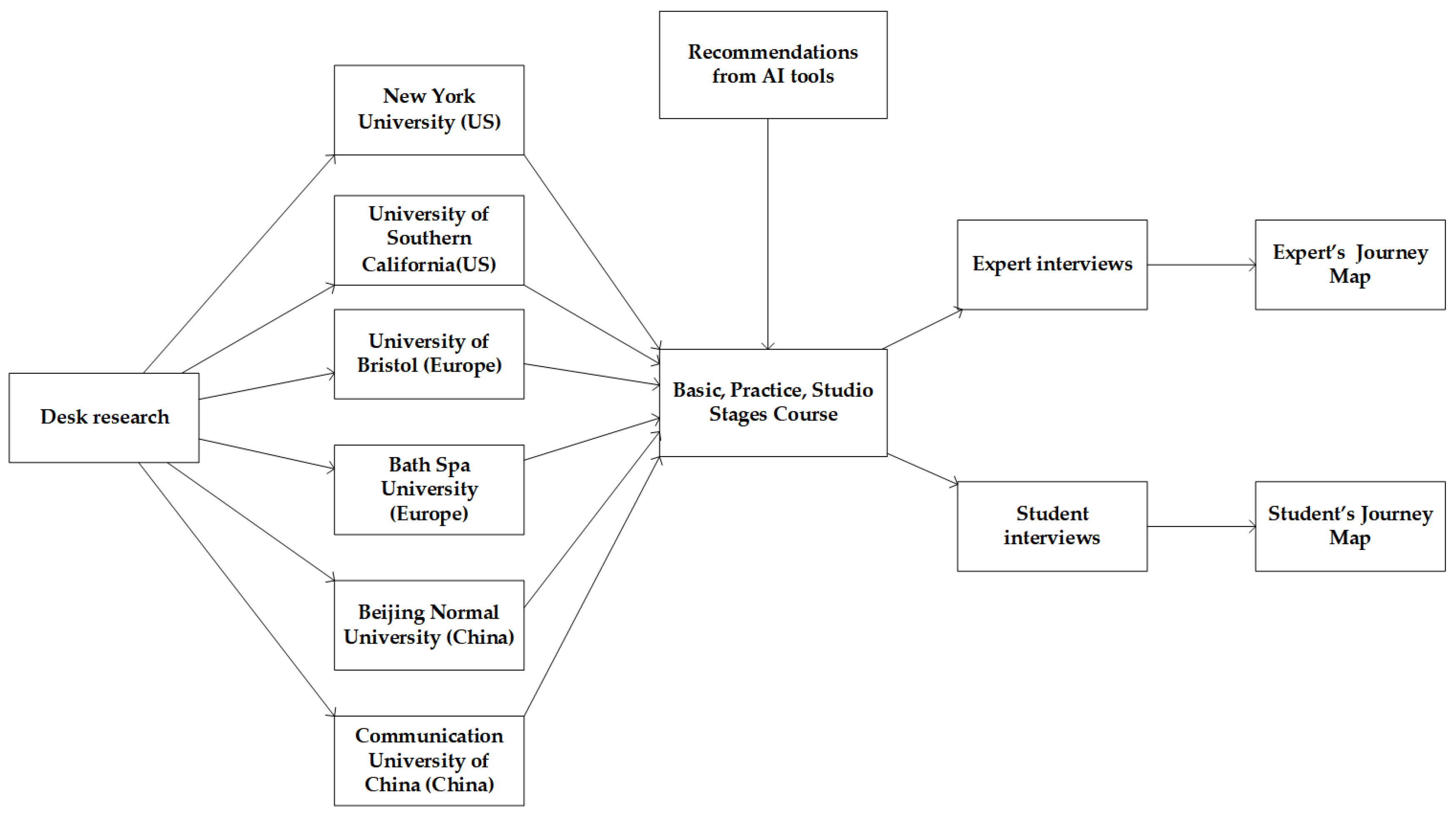
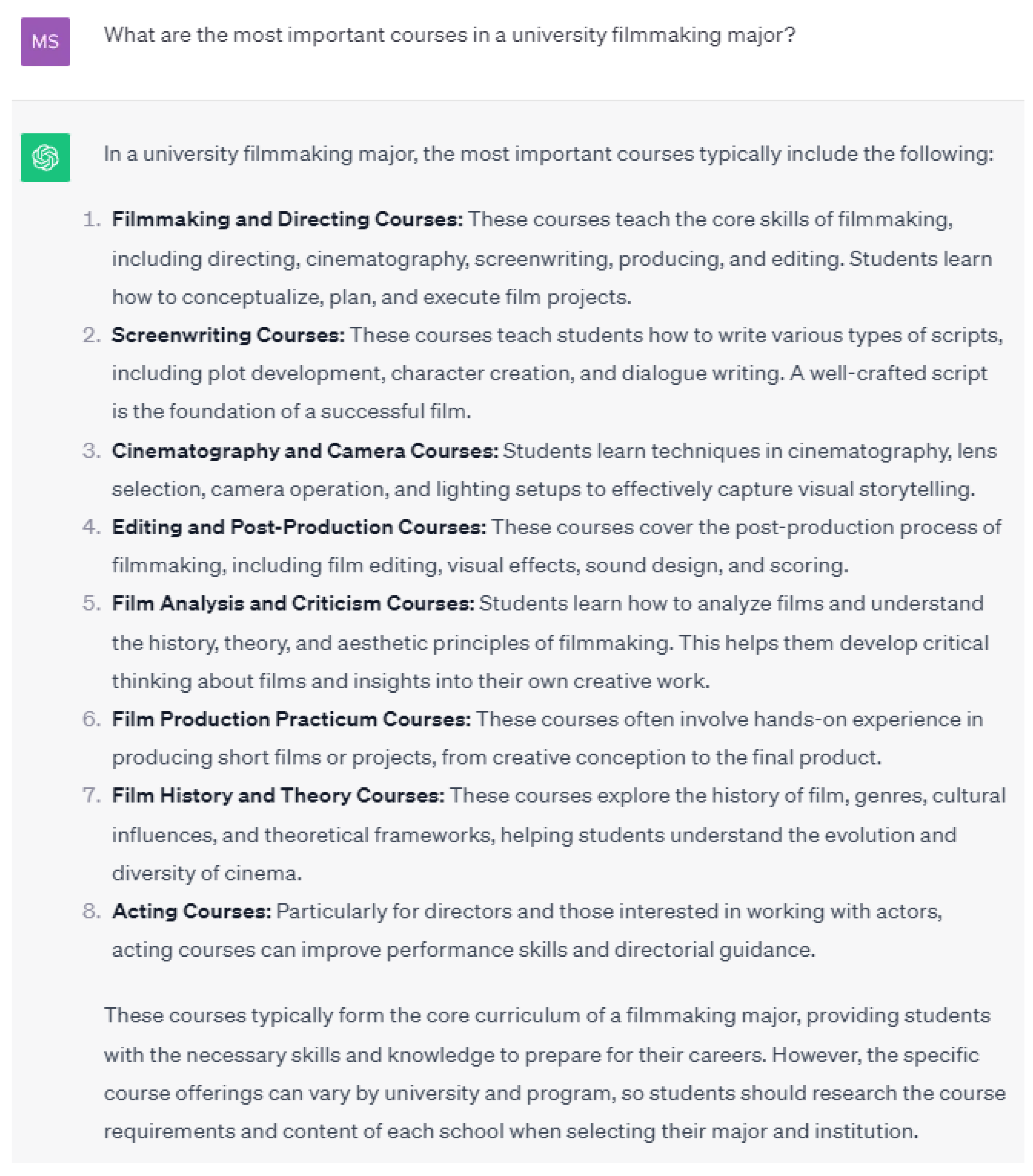
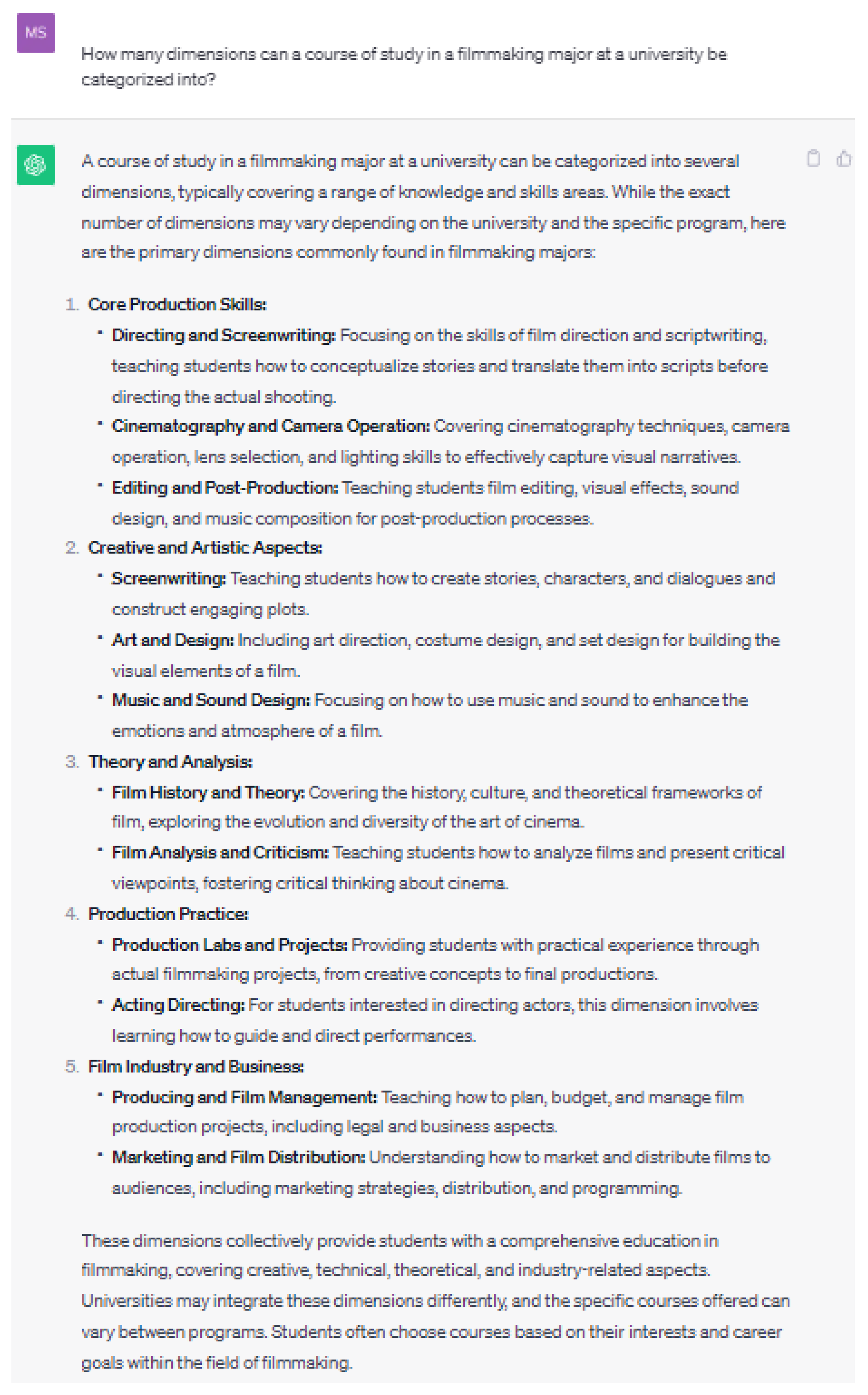
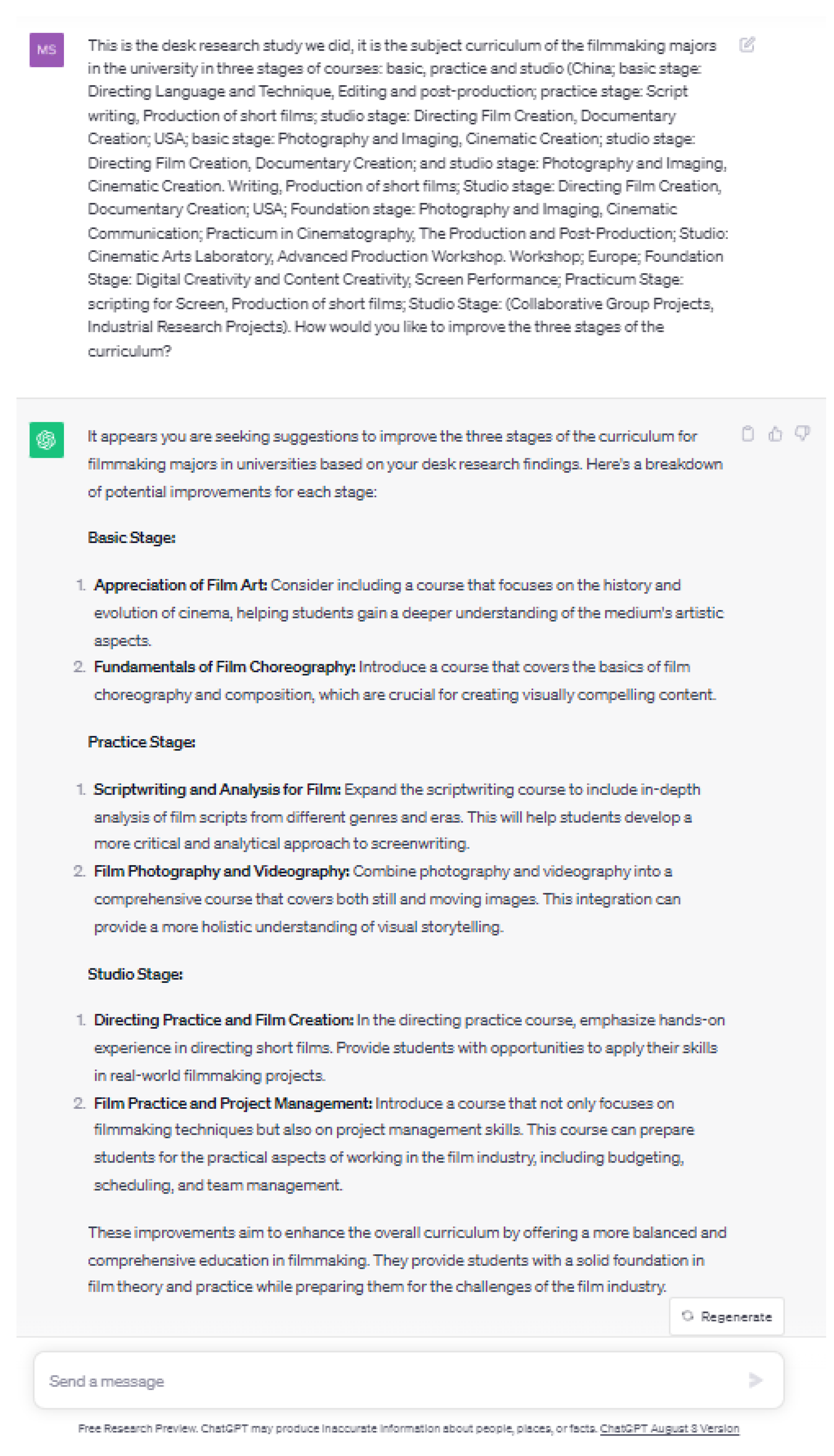
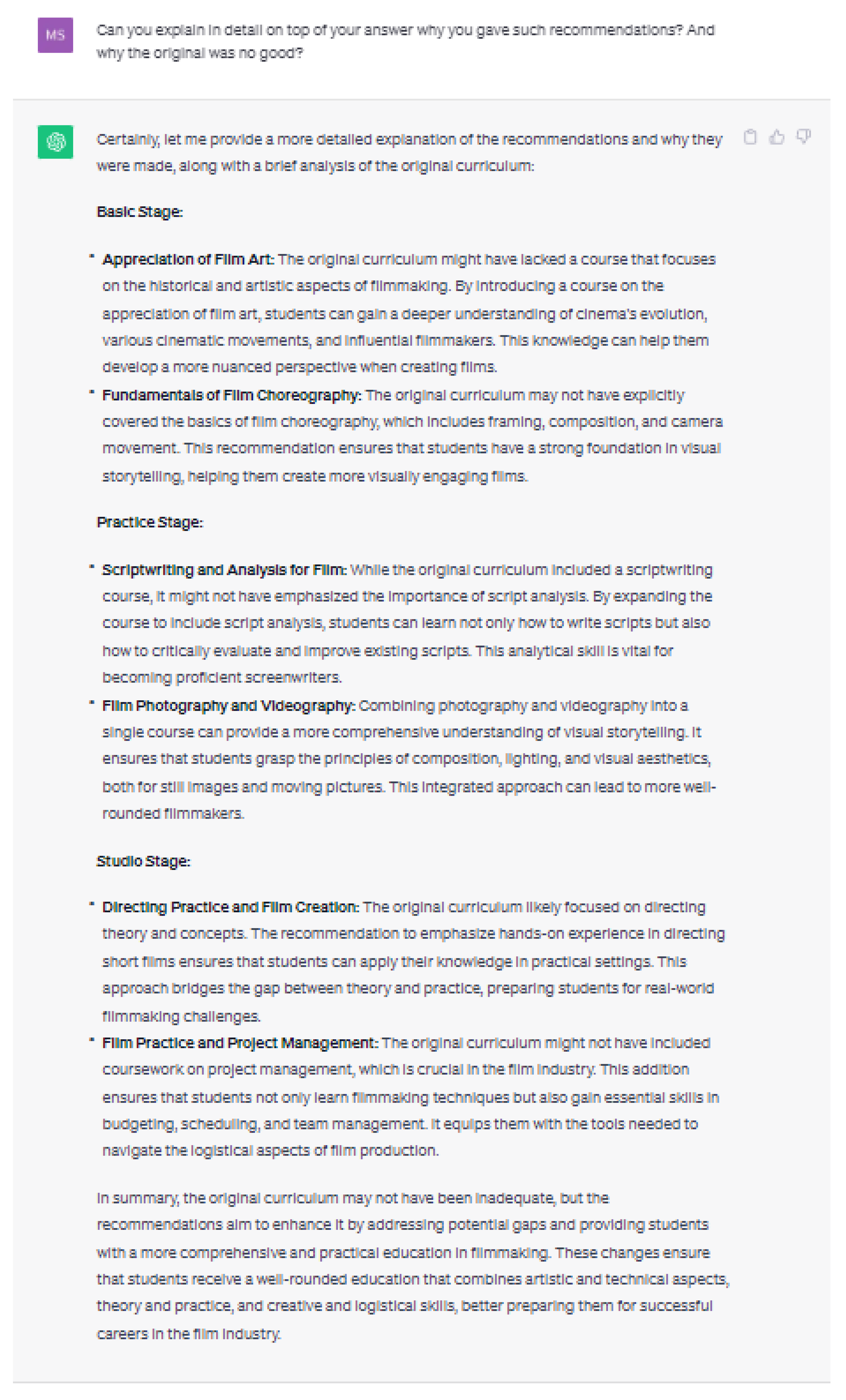
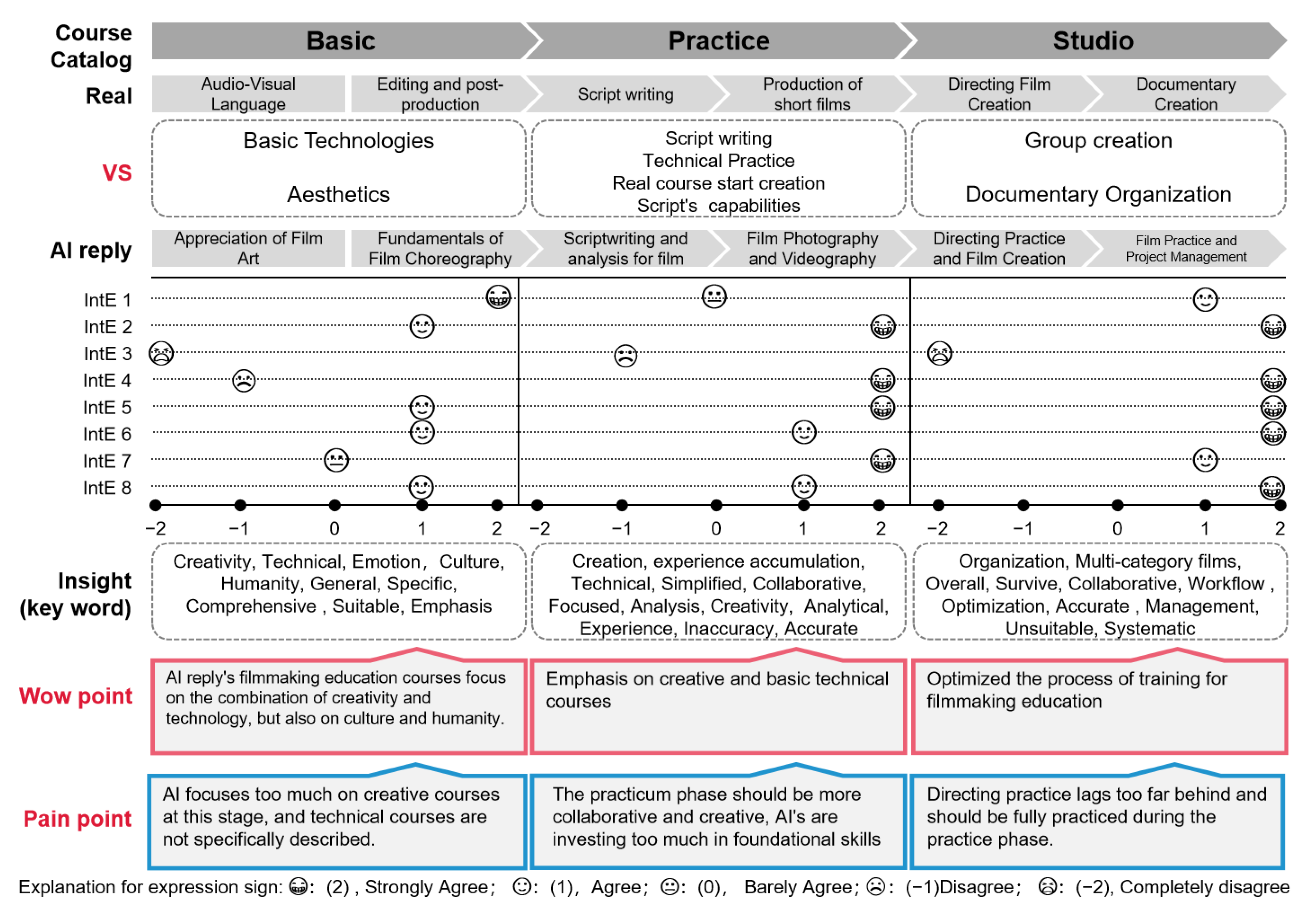

| Category | Article | Citations | Description |
|---|---|---|---|
| Management system | Popenici et al. [25] | 286 | Identify some of the challenges in using AI technologies for teaching, learning, student support, and management |
| Ge et al. [26] | 11 | AI for the creation of teaching management methods for higher education | |
| Maria et al. [27] | 20 | System for AI-based student diagnosis, assistance, and evaluation | |
| Ming et al. [28] | 11 | Assess the quality of education | |
| Jain et al. [29] | 72 | Assess a student’s understanding of a topic | |
| Lin et al. [30] | 37 | An intelligent counseling system that detects emotions | |
| Teaching support | Ocaña-Fernández et al. [31] | 82 | The digital language popularization of AI |
| Bates et al. [32] | 118 | Potential and actual implications for higher-education teaching | |
| Kong [33] | 62 | A model was designed to quantify the effect of applying AI in teaching art | |
| Saplacan et al. [34] | 12 | Digital interfaces use design to evoke positive emotions | |
| Dekker et al. [35] | 28 | The potential of AI to improve academic performance | |
| Frieder et al. [36] | 130 | Evaluate the help of AI in mathematics education | |
| Gilson et al. [37] | 50 | Evaluate the aid of AI in medical education | |
| Academic writing | Nazari et al. [38] | 82 | An AI-driven writing tool can be an effective tool |
| Salvagno et al. [16] | 183 | The aid of AI in academic writing | |
| Virtual experiments and simulations | Mirchi et al. [39] | 154 | AI tools are used for surgical and medical simulation training |
| Janpla et al. [40] | 8 | Testing the use of AI in e-learning environments | |
| Personalized learning | Meng et al. [41] | 42 | Personalized content for students |
| Villegas-Ch et al. [42] | 97 | Stimulating students’ interest in learning | |
| Thomas et al. [43] | 63 | Dynamically adjusted to suit individual learners | |
| Plagiarism | Gao et al. [21] | 177 | Comparing scientific abstracts generated via ChatGPT to original abstracts |
| Mohammad et al. [22] | 78 | Detecting plagiarism in academic papers generated via AI |
| Area | Basic | Practice | Studio | |||
|---|---|---|---|---|---|---|
| China | Directing Language and Technique | Editing and Post-Production | Script Writing | Production of Short Films | Directing Film Creation | Documentary Creation |
| US | Photography and Imaging | Cinematic Communication | Practicum in Cinematography | Production and Post-Production | Cinematic Arts Laboratory | Advanced Production Workshop |
| Europe | Digital Creativity and Content Creativity | Screen Performance | Scripting for Screen | The Production of Short Films | Collaborative Group Projects | Industrial Research Projects |
| Area | Basic | Practice | Studio | |||
|---|---|---|---|---|---|---|
| China | Directing Language and Technique | Editing and Post-Production | Script Writing | Production of Short Films | Directing Film Creation | Documentary Creation |
| US | Photography and Imaging | Cinematic Communication | Practicum in Cinematography | Production and Post-Production | Cinematic Arts Laboratory | Advanced Production Workshop |
| Europe | Digital Creativity and Content Creativity | Screen Performance | Scripting for the Screen | Production of Short Films | Collaborative Group Projects | Industrial Research Projects |
| AI | Appreciation of Film Art | Fundamentals of Film Choreography | Scriptwriting and Analysis for film | Film Photography and Videography | Directing Practice and Film Creation | Film Practice and Project Management |
| ID | Occupation/Field of Work | Profile | Experience in Using AI |
|---|---|---|---|
| IntE-1 | University teacher; musician; director; script writer | PhD in music; 10 years in soundtrack production, film production creator | Familiar with AI practices and has experience with using AI for scriptwriting |
| IntE-2 | University teacher; product designer | PhD in interaction design; 10 years of experience in prop making | Familiar with AI practice, has their own product design AI database, and is a technology enthusiast |
| IntE-3 | University teacher; brand designer | PhD in interaction design; experience in film branding design | Familiar with AI practices but experience is limited to text-generation AI |
| IntE-4 | University teacher; film director | PhD in interaction design | No experience with AI |
| IntE-5 | University teacher; film director | PhD in artistic business; 14 years teaching film production courses at universities, directs films | Familiar with AI practices and has tried various AI tools in film production |
| IntE-6 | University teacher | PhD in cinematography | Familiar with AI practices but limited to text-generation AI |
| IntE-7 | University teacher | PhD in interaction design | Familiar with AI practices and has tested various AI tools in filmmaking |
| IntE-8 | University teacher; visual communication designer | PhD in interaction design; 6 years of teaching experience in the Cinema Department | Familiar with AI practices and has tested various AI tools in filmmaking |
| IntS-1 | University student majoring in film production | Has 3 years of learning experience in filmmaking | Has tested AI in several aspects of filmmaking |
| IntS-2 | University student majoring in animation film | Has 4 years of learning experience in film animation | Has tested AI in several aspects of film animation |
| IntS-3 | University student majoring in film directing | First-year student in the Film Directing Program | No experience with AI |
| IntS-4 | Master’s degree student at a university, earning a master’s degree in filmmaking | Has 5 years of learning experience in filmmaking | Familiar with AI practices and has tried various AI tools in Filmmaking |
| IntS-5 | University student and filmmaking graduate | Ha s4 years of learning experience in filmmaking | Familiar with AI practices but limited to text generation AI |
| IntS-6 | University student majoring in directing animation | Has 2 years of learning experience in directing animation | No experience with AI |
| IntS-7 | Pre-master’s degree student majoring in filmmaking | Has 7 years of learning experience in filmmaking | Tried AI in several aspects of Filmmaking |
| IntS-8 | University student majoring in filmmaking | Has 4 years of learning experience in filmmaking | Familiar with AI practices but limited to text generation AI |
Disclaimer/Publisher’s Note: The statements, opinions and data contained in all publications are solely those of the individual author(s) and contributor(s) and not of MDPI and/or the editor(s). MDPI and/or the editor(s) disclaim responsibility for any injury to people or property resulting from any ideas, methods, instructions or products referred to in the content. |
© 2023 by the authors. Licensee MDPI, Basel, Switzerland. This article is an open access article distributed under the terms and conditions of the Creative Commons Attribution (CC BY) license (https://creativecommons.org/licenses/by/4.0/).
Share and Cite
Yang, W.; Lee, H.; Wu, R.; Zhang, R.; Pan, Y. Using an Artificial-Intelligence-Generated Program for Positive Efficiency in Filmmaking Education: Insights from Experts and Students. Electronics 2023, 12, 4813. https://doi.org/10.3390/electronics12234813
Yang W, Lee H, Wu R, Zhang R, Pan Y. Using an Artificial-Intelligence-Generated Program for Positive Efficiency in Filmmaking Education: Insights from Experts and Students. Electronics. 2023; 12(23):4813. https://doi.org/10.3390/electronics12234813
Chicago/Turabian StyleYang, Wei, Hyemin Lee, Ronghui Wu, Ru Zhang, and Younghwan Pan. 2023. "Using an Artificial-Intelligence-Generated Program for Positive Efficiency in Filmmaking Education: Insights from Experts and Students" Electronics 12, no. 23: 4813. https://doi.org/10.3390/electronics12234813






